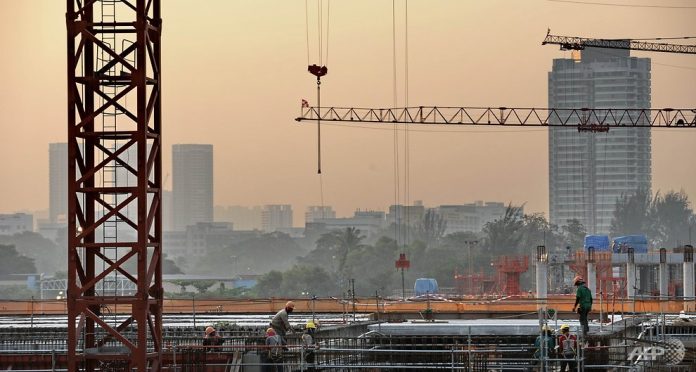The local construction sector, which has been showing signs of bottoming out, could find itself on shaky ground again following the latest property cooling measures, some economists said.
Advance estimates from the Ministry of Trade and Industry (MTI) on Friday (Jul 13) showed the industry shrunk by 4.4 per cent year-on-year in the second quarter, as weakness in private sector construction activities persisted.
While this marked the sector’s eighth straight quarter of contraction, the decline eased from the previous quarter’s negative 5.2 per cent.
Government officials also said in May that a pick-up in activities may be around the corner.
“Construction demand has started to pick up since the second half of last year. In the first quarter, demand increased primarily due to public sector demand (and) some pick-up in private sector construction,” an official said at a briefing to announce first-quarter GDP figures.
“Taken together, we think the construction sector will start to bottom up and we should see a pick-up in activities towards the latter half of this year or 2019.”
This could, however, change with the surprise property curbs announced on Jul 5.
“There are signs that it is bottoming out because of the rebound in the property market but now, the cooling measures will likely have a dampening effect on the sector,” Nomura economist Brian Tan said.
“I’d remain very cautious on construction as a source of growth.”
Aimed at cooling the market and keeping “price increases in line with economic fundamentals”, the Government hiked the Additional Buyer’s Stamp Duty (ABSD) rates and tightened loan-to-value (LTV) limits on residential property purchases.
Developers were also slapped with a non-remissible five per cent ABSD when they purchase en bloc properties for redevelopment, alongside a 10-percentage-point increase in the waivable ABSD to 25 per cent.
Described by some analysts as “heavy-handed”, the cooling measures are seen having the largest impact on the en bloc market and the private residential market. The resurgence in the former was supposed to be a boost to the construction sector when new condominium projects get underway.
“We had initially expected the construction sector to potentially bottom by end of 2018 but given that the recent cooling measures in the form of a hike to the ABSD and LTV tightening is likely to dampen the private residential market sentiments and activity in the near term, there may not be light at the end of the tunnel this year for the construction sector’s growth,” said OCBC Bank’s head of treasury research and strategy Selena Ling.
But observers are less certain about when the impact could kick in, citing projects that may be coming on stream soon.
“Don’t forget there were already deals done from all the en bloc activities. These construction projects are not the kind of things that you start and stop at a whim so it may take some time before it filters in,” said Mr Tan.
“But it might still put the brakes on the en bloc hopefuls.”
Maybank Kim Eng economists Chua Hak Bin and Lee Ju Ye wrote in a note that “severe” property measures are “hurting the construction outlook” though the sector is still likely to get some reprieve from the strong en bloc sales to date and rising value of contracts awarded.
To be sure, there is one economist with a contrarian view.
Mr Vishnu Varathan, head of economics and strategy for Mizuho Bank, thinks the latest cooling measures will not cause a dramatic slowdown in construction activity.
“Whatever that’s underway, developers will go ahead to finish it,” he said. “What the measures might do is cause a reconsideration among developers when it comes to pricing for land bids, but what it does not do is give cause for those who have already bought the land to hold back on construction.”
As for the impact on new projects, he reckoned: “The en bloc activity may not be as frantic but you may want to bear in mind that a lot of the impact would be around pricing potential. Developers and owners looking to encash will be calibrating their expectations and a deal may still go through.
“My proposition is that the cooling measures may not translate into an impact because some of that could be adjusted from a price perspective.”
The Government keeping residential land supply in the second half of 2018 on par with that in the first half also means that “public projects can be adjusted to pick up some of the buffer”.
Lastly, with the significant declines seen last year, it “must take something jarring” to worsen the year-on-year figures for the sector, added Mr Varathan.
Looking ahead, the economist expects contraction in the construction sector to continue easing to negative three to four per cent, from its current four to five per cent declines.
“This kind of gradual recovery is not outlandish to expect,” he said.
Tang See Kit
Source: www.channelnewsasia.com








































